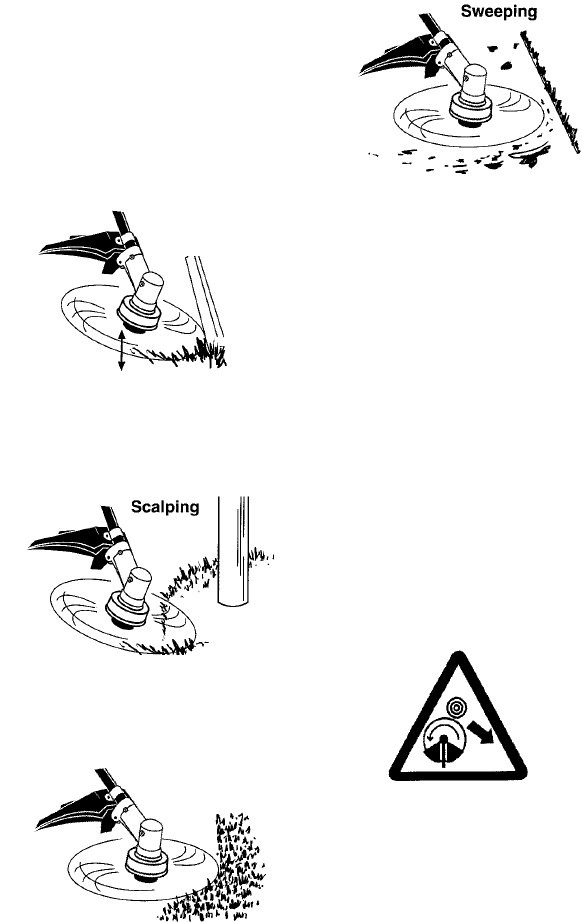
12
S For trimming or scalping, use less than full
throttletoincreaseline l ifeanddecreasehead
wear, especially:
S During light duty cutting.
S Near objects around which the line can
wrap such as small posts, trees or fence
wire.
S For mowing o r sweeping,use fullthrottle fora
good clean job.
TRIMMING -- Hold the bottom o f thetrimmer
head abou t 8cm above the ground andat an
angle. Allow only the tip of the line to make
contact. Do not force trimmer line into work
area.
Trimming
8 cm above
ground
SCALPING -- The scalping technique re-
moves unwanted vegetation down to the
ground. Hold the bottom of the trimmer head
about8cmabovethegroundandat anangle.
Allow the tip of the line to strike the ground
around trees, posts, m onuments, e tc. This
technique increases line wear.
MOWING -- Your trimmer is ideal for m owing
in places conventional lawn mowers cannot
reach. In the mowing position, keep the line
parallel to the ground. Avoid pressing the
head into the ground as this can scalp the
ground and damage the tool.
Mowing
SWEEPING-- Thefanningactionof therotat-
inglinecanbeusedtoblowaway loosedebris
from an area. Keep the line parallel to and
above the area surface and swing the tool
from side to side.
OPERATING INSTRUCTIONS FOR
USE WITH WEED BLADE
S Blad e Th ru s t is a reaction that only occurs
when using a bladed unit. This reaction can
cause serious injury such as amputation.
Carefully study this section. Itis importantthat
you under stand what causes blade thrust,
how you can reduce t he chance o f its
occurring, and how you can remain in control
of unit if blade thrust occurs.
S WHAT CAUSES BL AD E T HRU ST -- Blade
Thrust can occur when the spinning blade
contacts an object that it does not cut. This
contactcauses t he b ladetostopfor a ninstant
and t hen suddenly m ove or “thrust” a way
from the object that was hit. The “thrusting”
reaction can be violent enough to cause the
operator to be propelled in any direction and
lose control of the unit. The uncontrolled unit
can cause serious injury ifthe blade contacts
the operator or others.
S WHEN BLADE THRUST OCCURS --
BladeThrust can occur without warning if
the blade snags, stalls, or binds. This is
more likely to occur in a reas where it is
difficult to see the material being cut. By
using the unit properly , the occurrence of
blade thrust will be reduced and the
operator will be less likely to lose control.
S Cut only grass, weeds, and woody brush up
to 1 cm in diameter with the weed blade. Do
not let t he blade contact material it cannot cut
such as stumps, rocks, fences, m etal, etc., or
clusters of hard, woody b rush having a
diameter greater than 1 cm.
S Keep the blade sharp. A dull blade ismore
likely to snag and thrust.
S Cut only at full throttle. The blade will have
maximumcutting powerand isless likely to
bind or stall.
S “Feed” the blade deliberately and not too
rapidly.Thebladecan thrust away ifit isfed
too rapidly.


















